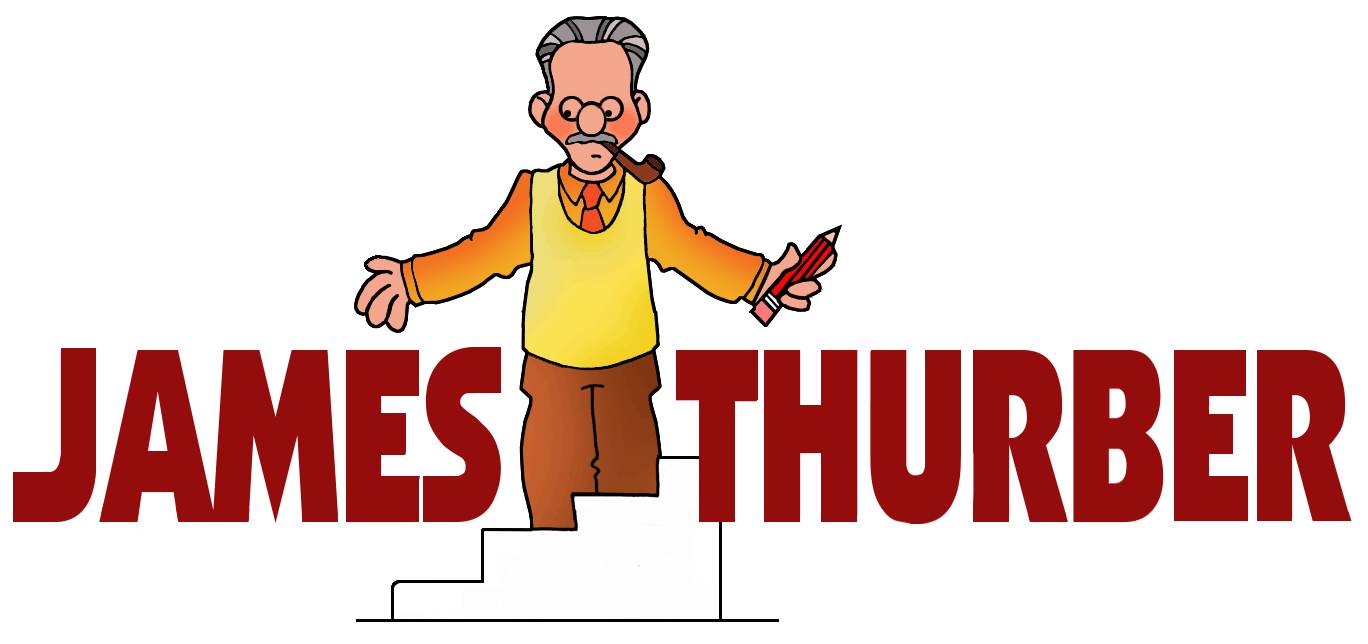James Thurber
Your list of Ohio cartoonist might
include Bill Waterson (Calvin and Hobbes), Cathy Guisewite
(Cathy) and Phillip Martin (ah, shucks, I wish I was
on your list). But, long before any of Ohio's current batch of
cartoonists put pencil to paper, humorist James Thurber made
his mark in Columbus, Ohio, and around the world. Thurber, known
for his witty cartoons in The New Yorker magazine, was also an
author, journalist, and playwright. He wrote more than 40 books
including
My World and Welcome To It and the short story The Secret
Life of Walter Mitty. He also wrote seventy-five fables and
numerous humorous essays. In an interview in 1939, Thurber said,
"I'm not an artist. I'm a painstaking writer who doodles for
relaxation."
Truth be told, I have a warm spot in my
heart when I read the works of Thurber. He's one of the few
writers I've ever discovered who has a similar style to me. I can
hear my voice when I read Thurber's words. I like that. I
especially like it since he was also a cartoonist. However, my
artwork looks nothing like his. I was originally inspired by
Charles Schulz and not James Thurber.
Thurber was born in Columbus in
1894. He had a brother, and anyone who has a brother knows about
the foolish things that brothers get into. James Thurber would
probably win in most conversations about crazy antics with your
siblings. He and his brother played a game of William Tell when
James was seven. If you know who William Tell is, you know that
this story has a bow and arrow involved. James, on the wrong end
of the arrow, was shot in the eye. He lost the eye and had vision
problems for the rest of his life. The problems kept him out of
sports and the military, but it allowed him to focus all of his energy
on his very imaginative and creative endeavors.
From 1913 to 1917, he attended The Ohio
State University and rented the house at 77 Jefferson Avenue that in
1984 became the Thurber House
Museum. While at the university, he was the editor of the
student magazine, the Sundial. Unfortunately, Thurber
never graduated from Ohio State. With his vision problems, he was
unable to participate in the required Reserve Officers' Training
Corps. A little too late for Thurber, 34 years after his death, he
was posthumously awarded his long-overdue degree.
After a year in Paris where he worked as
a code clerk for the U.S. Embassy, Thurber returned home to work as a
reporter for The Columbus Dispatch. He eventually also
worked for the Chicago Tribune and other newspapers. The
Tribune sent him back to Paris as a correspondent.
In 1925, Thurber moved to New York City
to work as an editor for the New York Evening Post. Two
years later, he moved on to The New Yorker magazine. He
didn't become known as a cartoonist until after the move to the Big
Apple. It was there, in 1930, that fellow editor, E. B. White
(Yep, the guy who wrote Charlotte's Web) found some of Thurber's
drawings in the trash and submitted them for publication. It must
have been a very lucky Thursday for Thurber, because White only came
into the office one day a week.
Thurber was quite successful with The
New Yorker as an editor from the 1920s to the 1950s. He
drew six covers and many classic illustrations for the magazine.
He drew his cartoons in the usual fashion in the 1920s and 1930s.
But, as his vision worsened, he had to change his method. He drew
on large sheets with a black crayon or on black paper with white
chalk. With the chalk drawings, the photographer needed to reverse
the colors for publication. In 1952, Thurber gave up drawing all
together. He was totally blind the last 26 years of his
life. In spite of his visual problems, Thurber produced more books
after his blindness than before he lost his sight.
In October, 1961, Thurber had a blood
clot on the brain. He underwent surgery and drifted in and out of
consciousness. He held on for almost a month, but his doctors said
that he had several small strokes and hardening of the arteries.
He passed away on November 2 at the age of 66.
In celebration of the 30th anniversary
of the Thurber House Museum in Columbus, more than twenty local Columbus
cartoonists were invited to make their own renderings of Thurber
cartoons in their own style. And, I was included in this
group! There were no rules. Imaginations were free to run
wild, and that is exactly what happened. The exhibition, hosted by
the Wild Goose Gallery, was then planned
to move to Jefferson Avenue for permanent exhibition.
In my particular drawing, I selected
Thurber's American Male Tied Up in a Typewriter Ribbon. If
you are too young to fully understand the frustration of that moment,
consider yourself a blessed member of a computer society. I
updated the art to the computer age and wrapped the American Male up in
a computer mouse cord. But, it was my intention to keep a very
true element of Thurber's drawing in my version. I tired to match
every curve and twist of the typewriter ribbon with my mouse cord.
Each generation has their own problems and frustration with
communication. But, I promise you, a mouse cord is a whole lot
less messy!

My piece of art exhibited for the 30th
Anniversary of the Thurber House Museum in Columbus.
